The Spy Who Loved Me (film)
7.4 /10 1 Votes
78% Rotten Tomatoes Genre Action, Adventure, Thriller Duration Language English | 7.1/10 IMDb Budget 14 million USD Country United Kingdom | |||||||||||||||||||||||||||||||||
 | ||||||||||||||||||||||||||||||||||
Cast (James Bond), (Major Anya Amasova), Curd Jürgens (Karl Stromberg), (Jaws), (Naomi), (General Anatol Gogol)Similar movies From Russia With Love , , Dr. No , , A View to a Kill , Tagline It's the BIGGEST. It's the BEST. It's BOND. And B-E-Y-O-N-D. | ||||||||||||||||||||||||||||||||||
The spy who loved me 1977 official trailer roger moore james bond movie hd
The Spy Who Loved Me (1977) is the tenth spy film in the James Bond series, and the third to star Roger Moore as the fictional secret agent James Bond. Barbara Bach and Curt Jürgens co-star. It was directed by Lewis Gilbert and the screenplay was written by Christopher Wood and Richard Maibaum.
Contents
- The spy who loved me 1977 official trailer roger moore james bond movie hd
- The spy who loved me movie clip can you swim 1977 hd
- Plot
- Cast
- Production
- Script
- Filming
- Music
- Release and reception
- Novelization
- Sale of props
- The spy who loved me movie clip ski chase 1977 hd
- References

The film takes its title from Ian Fleming's novel The Spy Who Loved Me, the tenth book in the James Bond series, though it does not contain any elements of the novel's plot. The storyline involves a reclusive megalomaniac named Karl Stromberg, who plans to destroy the world and create a new civilisation under the sea. Bond teams up with a Russian agent, Anya Amasova, to stop Stromberg.
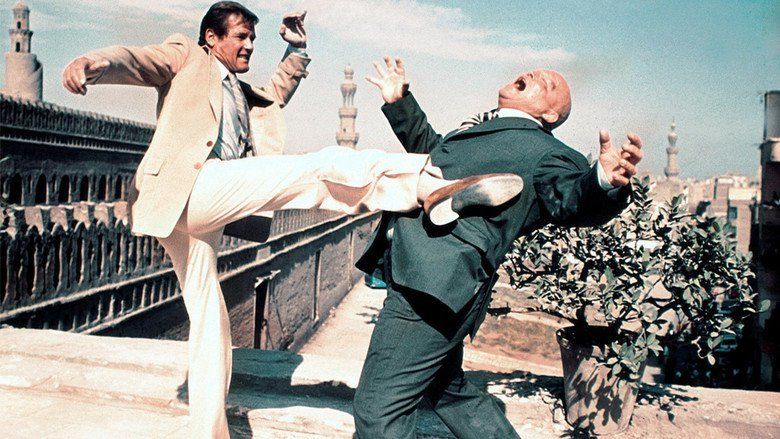
It was shot on location in Egypt (Cairo and Luxor) and Italy (Costa Smeralda, Sardinia), with underwater scenes filmed at the Bahamas (Nassau), and a new soundstage built at Pinewood Studios for a massive set which depicted the interior of a supertanker. The Spy Who Loved Me was well-received by critics. The soundtrack composed by Marvin Hamlisch also met with success. The film was nominated for three Academy Awards amid many other nominations and novelised in 1977 by Christopher Wood as James Bond, The Spy Who Loved Me.
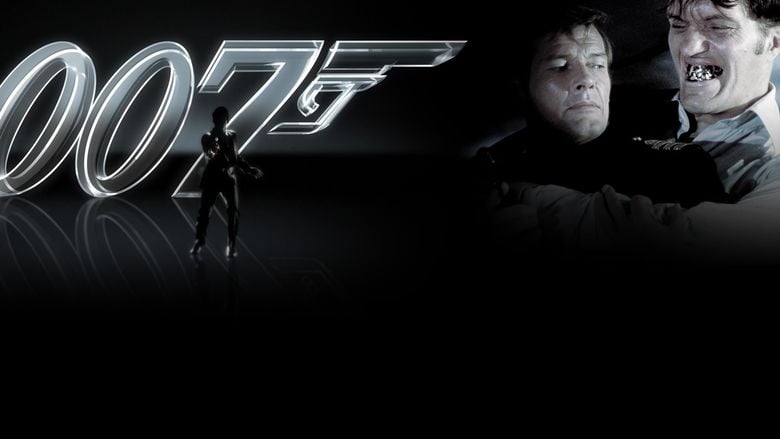
The spy who loved me movie clip can you swim 1977 hd
Plot
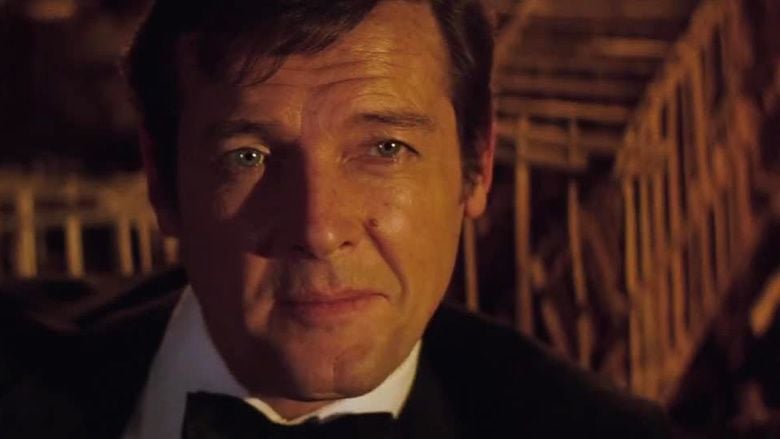
British and Soviet ballistic-missile submarines are mysteriously disappearing. James Bond—MI6 agent 007—is summoned to investigate. On the way to his briefing, Bond escapes an ambush by Soviet agents in Austria, killing their leader during a downhill ski chase. The plans for a highly advanced submarine tracking system are being offered in Egypt. There, he encounters Major Anya Amasova—KGB agent Triple X—his rival to recover the microfilm plans. They travel across Egypt together, encountering Jaws – a tall assassin with razor sharp steel teeth – along the way. Bond and Amasova reluctantly join forces after a truce is agreed by their respective British and Soviet superiors. They identify the person responsible for the thefts as the shipping tycoon, scientist, and anarchist Karl Stromberg.
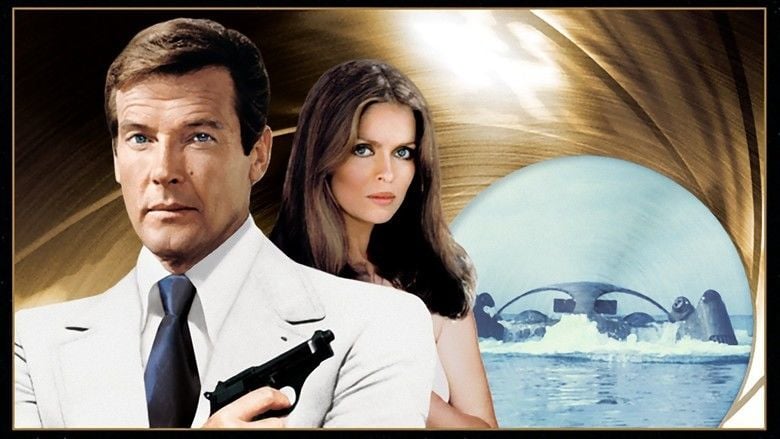
While travelling by train to Stromberg's base in Sardinia, Bond saves Amasova from Jaws, and their cooling rivalry turns to affection. Posing as a marine biologist and his wife, they visit Stromberg's base and discover that he had launched a mysterious new supertanker, the Liparus, nine months previously. As they leave the base, an unknown henchman on a motorcycle featuring a rocket sidecar, Jaws in a car, and Naomi, an assistant/pilot of Stromberg in an attack helicopter, chase them, but Bond and Amasova escape underwater when his car – a Lotus Esprit from Q Branch – converts into a submarine. Jaws survives a car crash and Naomi is killed when Bond fires a sea-air missile from his car which destroys her helicopter. The pair also encounter a fleet of Stromberg's minisubs which Amasova obliterates by launching mines. Bond finds out that the Liparus has never visited any known port or harbor. Amasova discovers that Bond killed her lover (as shown at the beginning of the movie), and she vows to kill Bond as soon as their mission is complete.
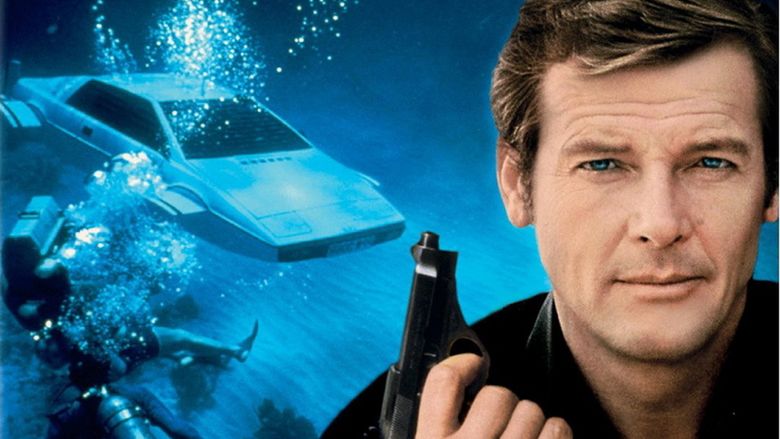
Bond and Amasova examine Stromberg's underwater Atlantis base from an American submarine, and confirm that he is operating the stolen tracking system. The Liparus captures the submarine. Stromberg sets his plan in motion: the simultaneous launching of nuclear missiles from British and Soviet submarines to destroy Moscow and New York City. This would trigger a global nuclear war, which Stromberg would survive in Atlantis, and subsequently a new civilisation would be established underwater. He leaves for Atlantis with Amasova. Bond escapes and frees the captured British, Russian and American sailors and they battle the Liparus's crew. Bond reprograms the submarines to fire missiles at each other, saving Moscow and New York City. The victorious submariners escape the sinking Liparus on the American submarine.

The submarine is ordered to destroy Atlantis but Bond insists on rescuing Amasova first. He confronts and kills Stromberg but again encounters Jaws, whom he drops into a shark tank. However, Jaws kills the shark and escapes. Bond and Amasova flee in an escape pod as Atlantis is sunk. Amasova reminds Bond that she has vowed to kill him as she picks up Bond's gun. Then, she admits to having forgiven him and the two embrace. The Royal Navy recovers the pod and the two spies are seen in an intimate embrace through its port window, much to the bemusement of their superiors on the ship.
Cast
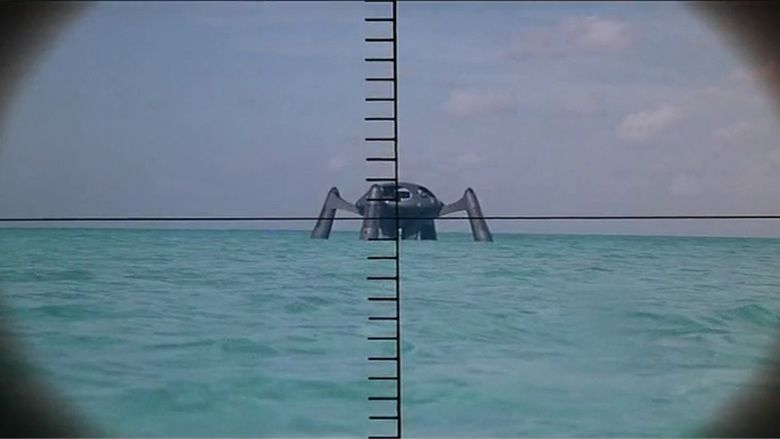
The assistant director for the Italian locations, Victor Tourjansky, had a cameo as a man drinking his wine as Bond's Lotus emerges from the beach. As an in-joke, he returned in similar appearances in another two Bond films shot in Italy, Moonraker and For Your Eyes Only.
Production
The Spy Who Loved Me in many ways was a pivotal film for the Bond franchise, and was plagued since its conception by many problems. The first was the departure of Bond producer Harry Saltzman, who was forced to sell his half of the Bond film franchise in 1975 for £20 million. Saltzman had branched out into several other ventures of dubious promise and consequently was struggling through personal financial reversals unrelated to Bond. This was exacerbated by the twin personal tragedies of his wife's terminal cancer and many of the symptoms of clinical depression in himself.
Another troubling aspect of the production was the difficulty in obtaining a director. The producers approached Steven Spielberg, who was in post-production of Jaws, but ultimately decided to wait to see "how the fish picture turns out". The first director attached to the film was Guy Hamilton, who directed the previous three Bond films as well as Goldfinger, but he left after being offered the opportunity to direct the 1978 film Superman, although Richard Donner took over the project. Eon Productions later turned to Lewis Gilbert, who had directed the earlier Bond film You Only Live Twice.
With a director finally secured, the next hurdle was finishing the script, which had gone through several revisions by numerous writers. The initial villain of the film was Ernst Stavro Blofeld; however Kevin McClory, who owned the film rights to Thunderball forced an injunction on Eon Productions against using the character of Blofeld, or his international criminal organisation, SPECTRE, which delayed production of the film further. The villain was later changed from Blofeld to Stromberg so that the injunction would not interfere with the production. Christopher Wood was later brought in by Lewis Gilbert to complete the script. Although Fleming had requested that no elements from his original book be used, the film characters of Jaws and Sandor are based on the novel characters Sol Horror and Sluggsy Morant, respectively. Horror is described as having steel-capped teeth, while Sluggsy had a clear bald head.
Since Ian Fleming permitted Eon to use only the name of his novel and not the actual novel, Fleming's name was moved for the first time from above the film's title to above "James Bond 007". His name reverted to the traditional location for Moonraker, the last Eon Bond film based on a Fleming novel before 2006's Casino Royale. However, the credit style first used in The Spy Who Loved Me has been used on all Eon Bond films since For Your Eyes Only, including Casino Royale.
Script
Broccoli commissioned a number of writers to work on the script, including Stirling Silliphant, John Landis, Ronald Hardy, Anthony Burgess, and Derek Marlowe. In the second volume of his autobiography, Burgess claims to have worked on an early treatment for the movie. The British television producer Gerry Anderson also stated that he provided a film treatment (although originally planned to be Moonraker) much similar to what ended up as The Spy Who Loved Me.
Eventually, Richard Maibaum provided the screenplay, and at first he tried to incorporate ideas from all of the other writers into his script. Maibaum's original script featured an alliance of international terrorists attacking SPECTRE's headquarters and deposing Blofeld, before trying to destroy the world for themselves to make way for a New World Order. However, this was shelved.
After Gilbert was reinstated as director, he decided to bring in another writer, Christopher Wood. Gilbert also decided to fix what he felt the previous Roger Moore films were doing wrong, which was writing the Bond character too much the way Sean Connery played him, and instead portray Bond closer to the books — "very English, very smooth, good sense of humour". Broccoli asked Wood to create a villain with metal teeth, Jaws, inspired by a brace-wearing henchman named Horror in Fleming's novel.
Broccoli agreed to Wood's proposed changes, but before he could set to work there were more legal complications. In the years since Thunderball, Kevin McClory had set up two film companies and was trying to make a new Bond film in collaboration with Sean Connery and novelist Len Deighton. McClory got wind of Broccoli's plans to use SPECTRE, an organisation that had first been created by Fleming while working with McClory and Jack Whittingham on the very first attempt to film Thunderball, back even before it was a novel, in the late 1950s. McClory threatened to sue Broccoli for alleged copyright infringement, claiming that he had the sole right to include SPECTRE and its agents in all films. Not wishing to extend the already ongoing legal dispute that could have delayed the production of The Spy Who Loved Me, Broccoli requested Wood remove all references to Blofeld and SPECTRE from the script.
In the film, Stromberg's scheme to destroy civilisation by capturing Soviet and British nuclear submarines and have them fire intercontinental ballistic missiles at two major cities is actually a recycled plot from Gilbert's previous Bond film, You Only Live Twice, which involved stealing space capsules to start a war between the Soviets and the Americans. The similarity was apparent in the climax; both films involved an assault on a heavily fortified enemy that had taken refuge behind steel shutters.
The scheme in which the villain wishes to destroy mankind to create a new race or new civilisation was also used in Moonraker, the next film after The Spy Who Loved Me. In Moonraker, the villain Hugo Drax had an obsession with starting human civilisation over again on Earth, using specially chosen "superior human specimens" based in space. The film Moonraker was also written by Christopher Wood.
Tom Mankiewicz, who worked on the three preceding Bond films, claims he was called in to do an extensive rewrite of the script. Mankiewicz says he did not receive credit, because Broccoli was limited to the number of non-English in key positions he could employ on the films to obtain Eady Levy assistance.
Filming
Tom Mankiewicz claims that Catherine Deneuve wanted to play the female lead and was willing to cut her normal rate from $400,000 per picture to $250,000, but Broccoli would not pay above $80,000.
The film was shot at the Pinewood Studios in London, Porto Cervo in Sardinia (Hotel Cala di Volpe), Egypt (Karnak, Mosque of Ibn Tulun, Gayer-Anderson Museum, Abu Simbel temples), Malta, Scotland, Hayling Island UK, Okinawa, Switzerland and Mount Asgard on Baffin Island in the then northern Canadian territory of Northwest Territories (now located in Nunavut).
As no studio was big enough for the interior of Stromberg's supertanker, and set designer Ken Adam did not want to repeat what he had done with SPECTRE's volcano base in You Only Live Twice — "a workable but ultimately wasteful set" — construction began in March 1976 of a new sound stage at Pinewood, the 007 Stage, at a cost of $1.8 million. To complement this stage, Eon also paid for building a water tank capable of storing approximately 1,200,000 gallons (5,500,000 litres). The soundstage was so huge that cinematographer Claude Renoir found himself unable to effectively light it due to his deteriorating eyesight, and so Stanley Kubrick visited the production, in secret, to advise on how to light the stage. For the exterior, while Shell was willing to lend an abandoned tanker to the production, the elevated insurance and safety risks caused it to be replaced with miniatures built by Derek Meddings' team and shot in the Bahamas. Stromberg's shark tank was also filmed in the Bahamas, using a live shark in a saltwater swimming pool. Adam decided to do experiments with curved shapes for the scenery, as he felt all his previous setpieces were "too linear". This was demonstrated with the Atlantis, which is a dome and curved surfaces outside, and many curved objects in Stromberg's office inside. For Gogol's offices, Adam wanted an open space to contrast M's enclosed headquarters, and drew inspiration from Sergei Eisenstein to do a "Russian crypt-like" set.
The main unit began its work in August 1976 in Sardinia. Don McLaughlan, then head of public relations at Lotus Cars, heard that Eon were shopping for a new Bond car. He drove a prototype Lotus Esprit with all Lotus branding taped over, and parked it outside the Eon offices at Pinewood studios; on seeing the car Eon asked Lotus to borrow both of the prototypes for filming. Initial filming of the car chase sequence resulted in disappointing action sequences. While moving the car between shoots, Lotus test driver Roger Becker impressed with his handling of the car and for the rest of filming on Sardinia, Becker became the stunt driver.
The motorcycle sidecar missile used in one chase sequence was built by film staff at Pinewood and used a standard Kawasaki Z900 and a custom made sidecar outfit. The sidecar was made large enough so that a stuntman could lie flat inside. It had two 10 inch scooter wheels on each side, a Suzuki 185 engine and the detached projectile was steered through a small solid rubber wheel at the front. A heavily smoked perspex nose allowed the stuntman sufficient visibility to steer the device whilst being entirely hidden from view. A pincer type lock held the sidecar in place until operated by the pilot via a solenoid switch. The sequences involving the outfit were speeded up as the weight of the sidecar made the outfit very difficult to control.
In October, the second unit travelled to Nassau to film the underwater sequences. To perform the car becoming a submarine, seven different models were used, one for each step of the transformation. One of the models was a fully mobile submarine equipped with an engine built by Miami-based Perry Submarines. The car seen entering the sea was a mock-up shell, propelled off the jetty by a compressed air cannon. During the model sequences, the air bubbles seen appearing from the vehicle were created by Alka-Seltzer tablets.
In September, production moved to Egypt. While the Great Sphinx of Giza was shot on the location, lighting problems caused the pyramids to be replaced with miniatures. While construction of the Liparus set continued, the second unit headed by John Glen departed for Mount Asgard, where in July 1976 they staged the film's pre-credits sequence. Bond film veteran Willy Bogner captured the action, staged by stuntman Rick Sylvester, who earned $30,000 for the stunt. This stunt cost $500,000 – the most expensive single movie stunt at that time. Additional scenes for the pre-credits sequence were filmed in the Bernina Range in the Swiss alps.
The production team returned briefly to the UK to shoot at the Faslane submarine base before setting off to Spain, Portugal and the Bay of Biscay where the supertanker exteriors were filmed. On 5 December 1976, with principal photography finished, the 007 Stage was formally opened by former Prime Minister Harold Wilson.
Music
The theme song "Nobody Does It Better" was composed by Marvin Hamlisch, written by Carole Bayer Sager, and performed by Carly Simon. It was the first theme song in the series to be titled differently from the name of the film, although the title is in the lyrics. It was nominated for Best Song but lost to "You Light Up My Life".
The song met immediate success and is featured in numerous films, including Mr. & Mrs. Smith (2005), Little Black Book, Lost in Translation, and Bridget Jones: The Edge of Reason (2004). In 2004, it was honoured by the American Film Institute as the 67th greatest song as part of their 100 Years Series.
The soundtrack to the film was composed by Marvin Hamlisch, who filled in for veteran John Barry, who was unavailable to work in the United Kingdom because of tax reasons. The soundtrack, in comparison to other Bond films of the time, is more disco-oriented and included a new disco rendition of "The James Bond Theme" titled "Bond 77"; several pieces of classical music were also included in the score. For instance, while feeding a duplicitous secretary to a shark, Stromberg plays Bach's "Air on the G String", which was famous for accompanying disappointed characters in Hamlet cigar commercials. He then plays the opening string section of the second movement, Andante, of Mozart's Piano Concerto No. 21 as his hideout Atlantis rises from the sea. The score also includes two pieces of popular film music scored by Maurice Jarre. The Doctor Zhivago theme, which is played on Anya's music box during the pre-credit sequence, and the theme from Lawrence of Arabia, which appears as background music during a desert sequence.
Release and reception
The Spy Who Loved Me opened with a Royal Premiere attended by Princess Anne at the Odeon Leicester Square in London on 7 July 1977. It grossed $185.4 million worldwide, with $46 million in the United States alone. On 25 August 2006, the film was re-released at the Empire Leicester Square Cinema for one week. It was again shown at the Empire Leicester Square 20 April 2008 when Director Lewis Gilbert attended the first digital screening of the film.
Eon executive Charles Juroe said that at a screening attended by Charles, Prince of Wales, during the Union Jack-parachute scene "I have never seen a reaction in the cinema as there was that night. You couldn't help it. You could not help but stand up. Even Prince Charles stood up." It was Roger Moore's favourite Bond film, and many reviewers consider it the best installment to star the actor. Christopher Null praised the gadgets, particularly the Lotus Esprit car. James Berardinelli of Reelviews said that the film is "suave and sophisticated", and Barbara Bach proves to be an ideal Bond girl – "attractive, smart, sexy, and dangerous". Brian Webster stated the special effects were "good for a 1979 [sic] film", and Marvin Hamlisch's music, "memorable". Danny Peary described The Spy Who Loved Me as "exceptional ... For once, the big budget was not wasted. Interestingly, while the sets and gimmicks were the most spectacular to date, Bond and the other characters are toned down (there's a minimum of slapstick humour) so that they are more realistic than in other Roger Moore films. Moore gives his best performance in the series ... [Bond and Anya Amasova] are an appealing couple, equal in every way. Film is a real treat – a well acted, smartly cast, sexy, visually impressive, lavishly produced, powerfully directed mix of a spy romance and a war-mission film." Janet Maslin of The New York Times considered the film formulaic and "half an hour too long, thanks to the obligatory shoot-'em-up conclusion, ... nevertheless the dullest sequence here" but praised Moore's performance and the film's "share of self-mockery", which she found refreshing.
The Times placed Jaws and Stromberg as the sixth and seventh best Bond villains (respectively) in the series in 2008, and also named the Esprit as the second best car in the series (behind the Aston Martin DB5).
Marvin Hamlisch was nominated for several awards such as the Academy Award for Best Song, Original Music Score, the Golden Globe Award for Best Original Score, Grammy Award for Best Score for a Motion Picture and the BAFTA Anthony Asquith Award for Film Music ("Nobody Does It Better") in 1978. The film was also nominated for the Academy Award for Best Art Direction (Ken Adam, Peter Lamont and Hugh Scaife) and a BAFTA for Best Production Design/Art Direction
The end credits state "James Bond Will Return in For Your Eyes Only", but following the success of Star Wars, the originally planned For Your Eyes Only was dropped in favour of the space-themed Moonraker for the next film. Most critics received the film positively: Rotten Tomatoes sampled 47 reviewers and judged 79% of the reviews to be positive.
Novelization
When Ian Fleming sold the film rights to the James Bond novels to Harry Saltzman and Albert R. Broccoli, he gave permission only for the title The Spy Who Loved Me to be used. Since the screenplay for the film had nothing to do with Fleming's original novel, Eon Productions, for the first time, authorised a novelisation based upon the script. This would also be the first regular Bond novel published since Colonel Sun nearly a decade earlier. Christopher Wood, who co-authored the screenplay, was commissioned to write the book titled James Bond, The Spy Who Loved Me.
The novelisation and the screenplay, although both written by Wood, are somewhat different. In the novelisation, SMERSH is still active and after James Bond. Their role begins during the pre-title. After the mysterious death of Fekkish, SMERSH appears yet again, this time capturing and torturing Bond for the whereabouts of the microfilm that retains plans for a submarine tracking system (Bond escapes after killing two of the interrogators). The appearance of SMERSH conflicts with a number of Bond stories, including the film The Living Daylights (1987), in which a character remarks that SMERSH has been defunct for over 20 years. It also differs from the latter half of Fleming's Bond novels in which SMERSH is said to have been put out of operation. Members of SMERSH from the novelisation include Amasova and her lover Sergei Borzov as well as Colonel-General Niktin, a character from Fleming's novel From Russia, with Love who has since become the head of SMERSH. In the book, Jaws remains attached to the magnet that Bond dips into the tank, as opposed to the film where Bond releases Jaws into the water.
Sale of props
The Lotus Esprit—capable of transforming from car to submarine in the movie—was purchased for £616,000 at a London auction in October 2013 by Elon Musk, who plans to rebuild the vehicle and attempt to make the fictional dual-purpose car be an actual dual-purpose car (underwater and on land).
The spy who loved me movie clip ski chase 1977 hd
References
The Spy Who Loved Me (film) WikipediaThe Spy Who Loved Me (film) IMDbThe Spy Who Loved Me (film) Rotten TomatoesThe Spy Who Loved Me (film) themoviedb.org
